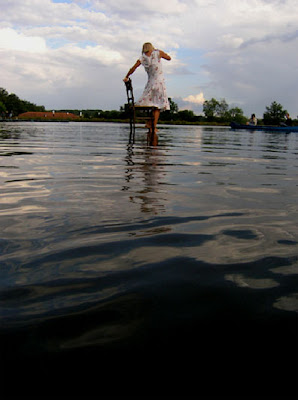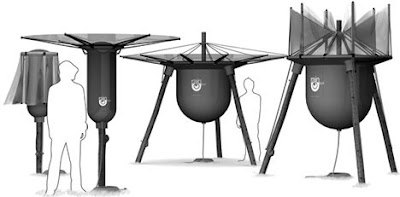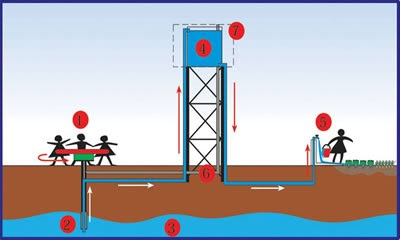Water is obviously something we rely on for a number of things beyond mere existence. At the root of water, however, is it’s ability to sustain us both physically and spiritually. It’s disheartening then to see how much we take this for granted, or exploit and destroy this seemingly ubiquitous (yet actually very precious) resource. In this not, a couple of posts – one highlighting water and it’s use. The second following up with some more active and grandiose interventions that explain a lot about we misuse, and inevitably are forced to be creative in curing these ailments.

:: images via Inhabitat
Groovy. Um, yeah… that’s exactly the word I was thinking. In a similar vein, I was brought back to the agro-evocative rolling lawn-watering-tractor when I saw this ‘visionary’ new product called Beyflo, by. Is this a machine for efficient watering? Maybe, but perhaps it’s a substitute for our laziness… via The Design Blog: “If technology cannot reduce our daily, often loathed, chores into automatic acts of programmed machines, then what’s the fun. …The designer says that in envisioning this project, he has also taken in the future marketing considerations. People would be so very lazy in future – thanks to all the machines – that this device would be a complete hit, without any doubt.” 
:: new lazy – image via The Design Blog

:: old lazy – via the HardwareStore
While tapping into our innate and future laziness is one thing, it’s time to get squarely into the sublimely silly. ‘Local River’ is a fixture and/or installation by Mathieu Lahanneur (whose previously featured Bell Aire, bordered on the fringes of silly but was soundly within reason). This pieced showed up many spots on the web, such as Treehugger as it plugged as a “…home storage unit for fish and greens.” This storage is handled via a microcosmic ecosystem: “This DIY fish-farm-cum-kitchen-garden is based on the principle of aquaponics coupled with the exchange and interdependence of two living organisms – plants and fish. …The plants extract nutrients from the nitrate-rich dejecta of the fish. In doing so they act as a natural filter that purifies the water and maintains a vital balance for the eco-system in which the fish live. The same technique is used on large-scale pioneer aquaponics/fish-farms, which raise tilapia (a food fish from the Far East) and lettuce planted in trays floating on the surface of ponds.”

:: image via Treehugger
While definitely grounded in realistic terms of aquaculture – there seems missing an economy of scale in this countertop model which seems to be missing a viable opening in the very closed loop system created here that smacks less of ecosystems and more of fish farming. I wonder what John and Nancy Jack Todd thing of these guys?
While I may poke fun as some of the automated technologies – or poke a finger at the ridiculousness of your own personal local river – the use of our water is not a laughing manner. There are definitely technologies that provide better use of water – I use them every day when designing – low-flow drip irrigation, rain and moisture sensors, Evapotranspiration-data linked controllers, and more accurate spray coverage. All of these strategies are aimed at using water when and where it is needed for plant growth – nothing less, nothing more. These systems still need people to specify, install, monitor, and adjust. When technology aims to provide a substitute for our own personal ‘eyes on the field’, or worse sub for our laziness, it becomes problematic. Things break, need adjustment, and weather may just not cooperate with our finely calibrated equipment.
I like simple solutions over technological ones… perhaps it is my dad’s wisdom to always get a car without automatic stuff – because it’s just one more thing to break (sorry day, I love the keyless entry and power windows). Don’t get me wrong. I have the same gee-whiz reaction to technological marvels that many of us do… but let’s think about it. Water is pretty simple. Fall from sky, capture to reuse, purify/treat to drink, release (preferably in the same or better form than you found it) back into hydrologic cycle… gravity does most of the work – we just have to keep our fingers and chemicals out of it along the route. So technology is great – but perhaps rather than another expensive electronic gizmo – it’s merely a merry-go-round…?






